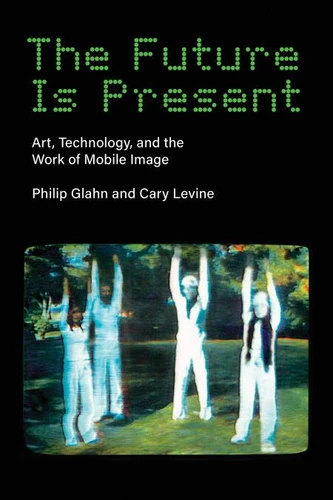The Future Is Present. Art, Technology, and the Work of Mobile Image
Par : ,Formats :
Disponible dans votre compte client Decitre ou Furet du Nord dès validation de votre commande. Le format ePub protégé est :
- Compatible avec une lecture sur My Vivlio (smartphone, tablette, ordinateur)
- Compatible avec une lecture sur liseuses Vivlio
- Pour les liseuses autres que Vivlio, vous devez utiliser le logiciel Adobe Digital Edition. Non compatible avec la lecture sur les liseuses Kindle, Remarkable et Sony
- Non compatible avec un achat hors France métropolitaine
 , qui est-ce ?
, qui est-ce ?Notre partenaire de plateforme de lecture numérique où vous retrouverez l'ensemble de vos ebooks gratuitement
Pour en savoir plus sur nos ebooks, consultez notre aide en ligne ici
- Nombre de pages336
- FormatePub
- ISBN978-0-262-37873-4
- EAN9780262378734
- Date de parution18/06/2024
- Protection num.Adobe DRM
- Taille70 Mo
- Infos supplémentairesepub
- ÉditeurThe MIT Press
Résumé
A critical history of the pioneering art and technology group Mobile Image and their prescient work in communications, networking, and information systems. In The Future Is Present, Philip Glahn and Cary Levine tell the fascinating history of the visionary art group Mobile Image-founded by Kit Galloway and Sherrie Rabinowitz in 1977-which appropriated emerging technologies, from satellites to electronic message platforms.
Based in Los Angeles, this under-studied collective worked amid urban crisis, a techno-boom, consolidating media power, and ascendant neoliberal politics. Mobile Image challenged fundamental conventions of the public sphere, democracy, communication, and political participation, as well as notions of power, representation, and identity. Glahn and Levine argue not only for the historical importance of Mobile Image, but also for a critical artistic process that is at once analytic and transformative.
They weave themes such as embodiment and its mediation, public/private dialectics, and techno-utopian vision throughout the book, binding these projects to discourses around race, gender, and class, as well as margin and center, the local and the global. In today's world of ubiquitous digital re/production, networking, and social media, The Future Is Present shows how the work of Mobile Image continues to have profound implications for art, technology, and the politics of public and private experience.
Based in Los Angeles, this under-studied collective worked amid urban crisis, a techno-boom, consolidating media power, and ascendant neoliberal politics. Mobile Image challenged fundamental conventions of the public sphere, democracy, communication, and political participation, as well as notions of power, representation, and identity. Glahn and Levine argue not only for the historical importance of Mobile Image, but also for a critical artistic process that is at once analytic and transformative.
They weave themes such as embodiment and its mediation, public/private dialectics, and techno-utopian vision throughout the book, binding these projects to discourses around race, gender, and class, as well as margin and center, the local and the global. In today's world of ubiquitous digital re/production, networking, and social media, The Future Is Present shows how the work of Mobile Image continues to have profound implications for art, technology, and the politics of public and private experience.
A critical history of the pioneering art and technology group Mobile Image and their prescient work in communications, networking, and information systems. In The Future Is Present, Philip Glahn and Cary Levine tell the fascinating history of the visionary art group Mobile Image-founded by Kit Galloway and Sherrie Rabinowitz in 1977-which appropriated emerging technologies, from satellites to electronic message platforms.
Based in Los Angeles, this under-studied collective worked amid urban crisis, a techno-boom, consolidating media power, and ascendant neoliberal politics. Mobile Image challenged fundamental conventions of the public sphere, democracy, communication, and political participation, as well as notions of power, representation, and identity. Glahn and Levine argue not only for the historical importance of Mobile Image, but also for a critical artistic process that is at once analytic and transformative.
They weave themes such as embodiment and its mediation, public/private dialectics, and techno-utopian vision throughout the book, binding these projects to discourses around race, gender, and class, as well as margin and center, the local and the global. In today's world of ubiquitous digital re/production, networking, and social media, The Future Is Present shows how the work of Mobile Image continues to have profound implications for art, technology, and the politics of public and private experience.
Based in Los Angeles, this under-studied collective worked amid urban crisis, a techno-boom, consolidating media power, and ascendant neoliberal politics. Mobile Image challenged fundamental conventions of the public sphere, democracy, communication, and political participation, as well as notions of power, representation, and identity. Glahn and Levine argue not only for the historical importance of Mobile Image, but also for a critical artistic process that is at once analytic and transformative.
They weave themes such as embodiment and its mediation, public/private dialectics, and techno-utopian vision throughout the book, binding these projects to discourses around race, gender, and class, as well as margin and center, the local and the global. In today's world of ubiquitous digital re/production, networking, and social media, The Future Is Present shows how the work of Mobile Image continues to have profound implications for art, technology, and the politics of public and private experience.



